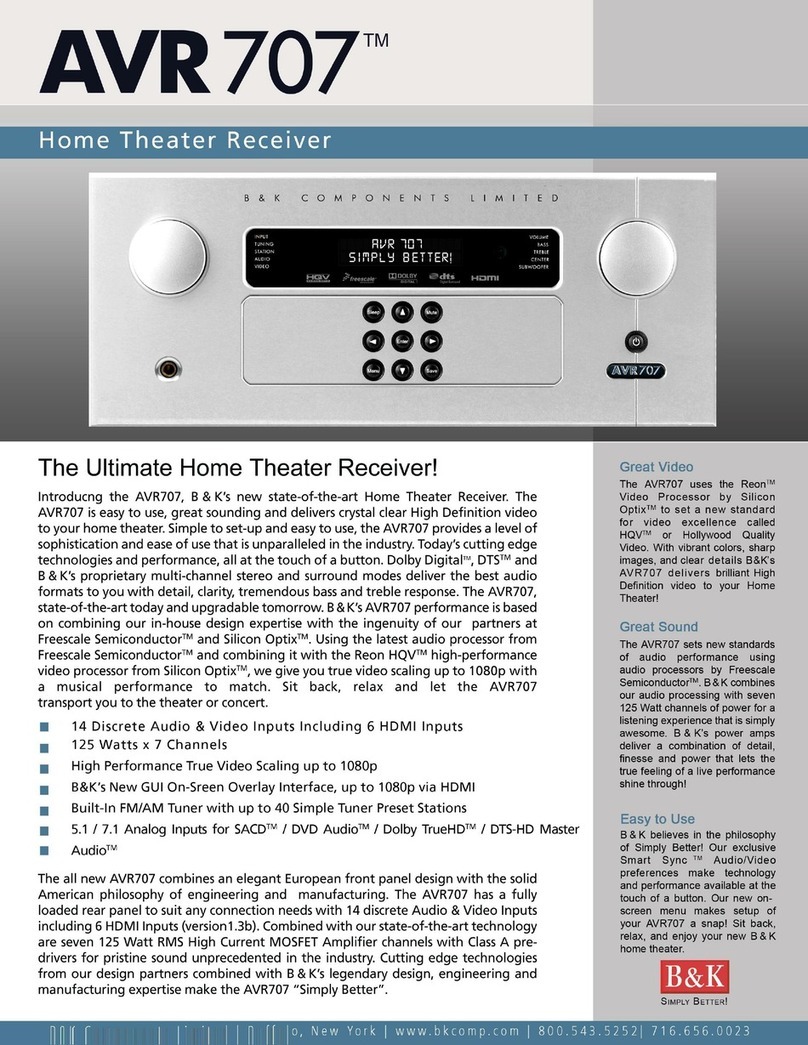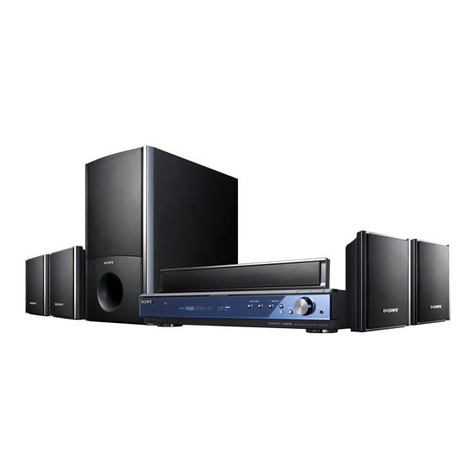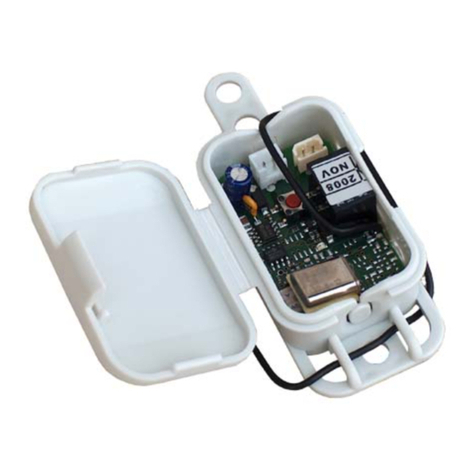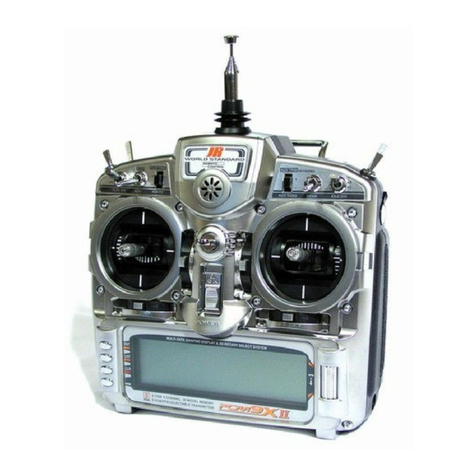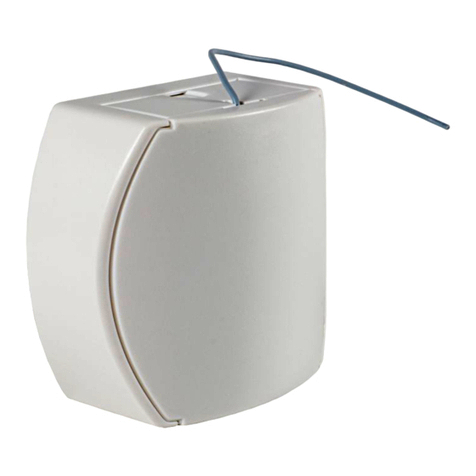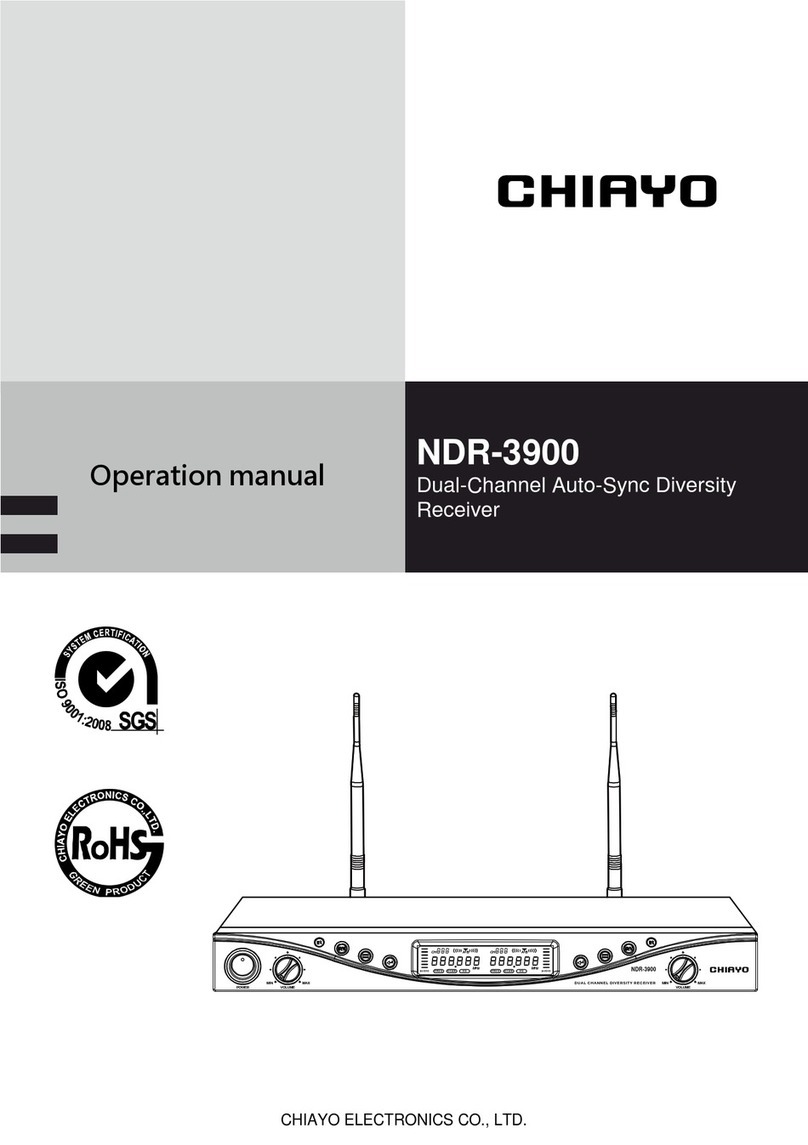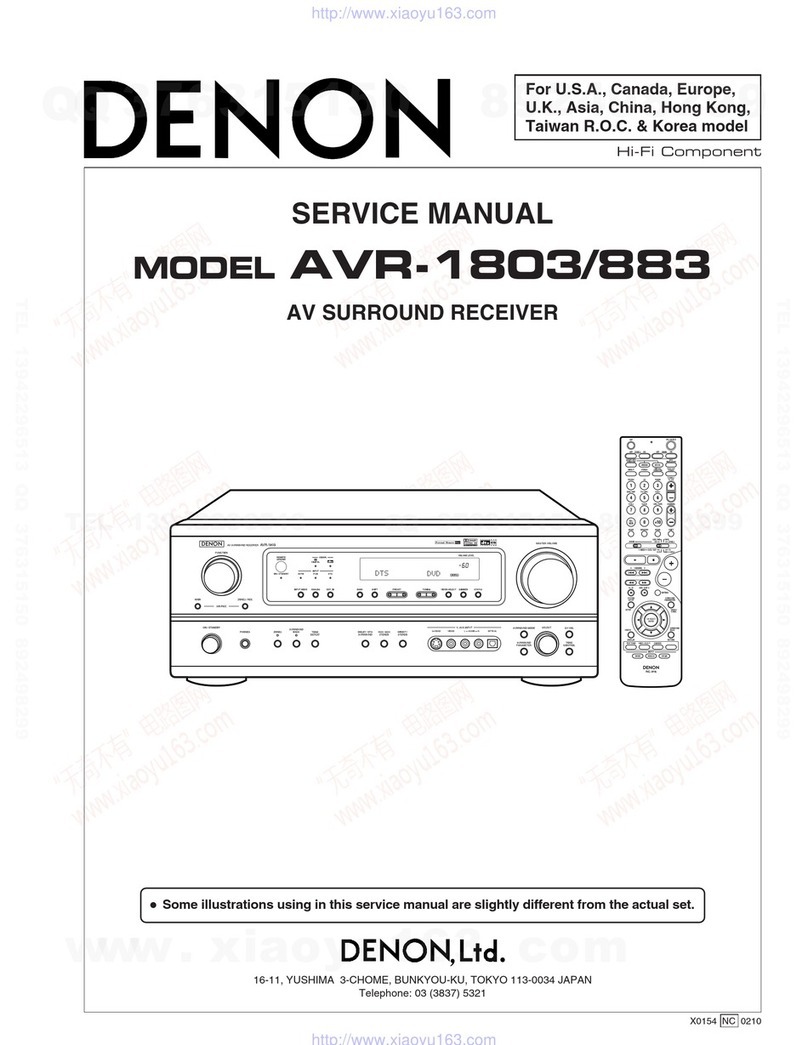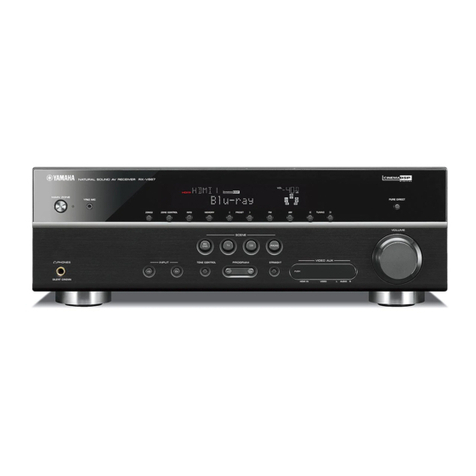Airfonix AFX-19AR050 User manual

User Manual
Airfonix T Series Wireless Transmitter Models:
Airfonix R Series Wireless Receiver Models:
AFX-19PR001
AFX-19PT102
AFX-19PT002
AFX-19AR050

EN
2www.airfonix.com
Important Safety Instructions
TO REDUCE THE RISK OF FIRE, ELECTRICAL SHOCK OR PRODUCT DAMAGE, DO NOT EXPOSE THE BOTTOM
OF THE TRANSMITTER OR RECEIVER TO RAIN, MOISTURE, DRIPPING OR SPLASHING. PLEASE ENSURE THAT
NO OBJECTS FILLED WITH LIQUIDS, SUCH AS VASES, ARE PLACED ON THE TRANSMITTER OR RECEIVER.
FOR YOUR SAFETY, READ AND RETAIN ALL SAFETY AND OPERATING INSTRUCTIONS. FOLLOW ALL
WARNINGS IN THIS MANUAL AND ON THE UNIT.
POWER SOURCE
To avoid any malfunctions of the unit, and to protect against electrical shock, re or physical injury,
please observe the following:
This system has been designed to work with 100-240 volt AC current. Connection to a line voltage other•
than that may create a safety and re hazard and may damage the system. If you are unsure of the type of
power supply to your home, consult your local dealer or power company.
Do not defeat the purpose of the polarized plug. A polarized plug has two blades, with one wider than the•
other. The wide blade is provided for your safety. If the provided plug does not t into your outlet, consult
an electrician for replacement of the obsolete outlet.
Do not run power cords under rugs or carpets or place heavy objects on them.•
Damaged or deformed power cords are hazardous and should be replaced immediately by a qualied service technician.•
LOCATION
Air vents are provided in the cabinet to prevent the build up of excessive temperatures inside the unit. Do•
not place the unit in closed spaces, cover it with anything, or otherwise block the vents.
Keep the units away from heat sources such as re pits, heating vents, central heating radiators and electric•
heaters. Never expose to continuous direct sunlight.
Keep the unit away from strong magnetic elds.•
CARE
The unit is splash proof only. Do not submerge in water.•
Do not insert or drop anything into the unit through the air vents as this could cause serious damage,•
possibly resulting in re.
Do not place any object containing water or other liquids on the unit. In the event that liquid should enter•
the cabinet, unplug the unit at once and contact the retailer or service center immediately.
Do not remove the cabinet. Touching parts inside the cabinet could result in electrical shock and damage to the unit.•
Unplug the unit and the AC power adapter from the electrical outlet during lightning storms or when•
unused for long periods of time to prevent damage.
To avoid electrical shock and/or damage to the unit, do not handle the transmitter, receiver, external•
antenna, connecting cables or AC power adapter with wet hands.
The AC power adapter receives power as long as it is connected to the electrical outlet, even if the power switch on•
the unit is turned off. Always remove the AC power adapter from the electrical outlet before inspecting the adapter.
Use only the AC power adapter suppiled with the unit. This adapter is designed specically for the unit.•
NON-USE PERIODS
ALWAYS turn the power OFF when not in use. When left unused for long periods of time, the unit should•
be unplugged from the AC outlet.
VOLUME CONTROL
Do not turn up the volume while listening to a portion with very low level input or no audio signal. The•
speaker may be damaged when a peak level portion is played.
CLEANING
Clean only with a dry or slightly damp cloth. Do not use any cleansing agents or solvents. Unplug the•
product from the wall outlet before cleaning.
SERVICE
Do not open the cabinet of any components. There are no user-serviceable components in the product.•
Opening the cabinets may present a shock hazard, and any modication to the product will void your
warranty.
Do not attempt to service the unit yourself. If water or any metal objects such as paper clips, wire or staples•
accidentally fall inside, disconnect the unit from the power source immediately and consult an authorized
service center.
SAVE THESE INSTRUCTIONS

EN
3
www.airfonix.com
Thank you for purchasing your Airfonix™ dual band Smart Channel™ wireless system. Airfonix
professional wireless audio products offer the exibility to arrange your wireless audio system to suit
your current needs. You can easily expand your system by adding models to accommodate specic
venues or location requirements. Use a combination of at least two of these products (one T Series
wireless transmitter with one R Series wireless receiver) to create the perfect wireless solution.
This manual covers the features, setup, and use for the following models:
In addition to this manual, you will nd a Quick Start Guide for each component you have purchased.
Although these products are designed for easy operation, before you start we suggest you take the
time to review these manuals to fully understand and take advantage of all the features in this system.
Introduction
Airfonix redenes wireless audio with the industry’s most advanced products for the professional and
semi-pro audio markets. The products deliver uncompressed, 24-bit HDTV-compliant audio at 48 KHz
sampling rate and are designed to retrot any active or passive speaker, thereby bringing the freedom
of wireless capability to any wired audio system.
Airfonix products boast Smart Channel capability, a patent-pending technology developed by SST that
automatically searches for and selects an uncongested channel from both the 2.4 GHz and 4.9-5.8 GHz
ISM bands. Because of this unique dual-band operation and Smart Channel capability, Airfonix products
are virtually impervious to interference from co-located wireless equipment. The result is clean, true
HDTV audio delivered wirelessly with the industry’s most sophisticated transmission system developed
especially for the stringent demands of professional users.
Every wireless system consists of at least two components–a transmitter and a receiver, both of which
must be paired and tuned to the same channel. Select the T Series transmitter that suits your audio
source input preferences, either model AFX-19PT002 or AFX-19PT102. You may connect two different
audio sources to each of these models and switch between them by remote control or by using the
button on the top of the unit.
The Airfonix R Series receivers are designed to retrot any active or passive speaker, bringing the
freedom of wireless capability to any wired audio system. If your venue is large, with the speakers placed
far apart, dock a receiver to each speaker.
The R Series receivers can be mounted to your speakers with the included hardware or sit vertically
using the stands. If your speakers are close together, select either R Series model AFX-19PR001 for
active (powered) speakers or R Series model AFX-19AR050 for passive speakers. If your speakers are
placed farther apart, use one R Series receiver for each speaker.
All units will be secure when you properly pair your transmitter with your receivers. You may use two
receivers with each transmitter and setup different channels for up to four wireless systems within a 150
foot range.
The system will accommodate 4 to 8 ohms output. Any system with 70V will not work with these products.
About Airfonix Wireless
Creating Your Airfonix Wireless System
Dual Band, two-channel wireless 50W mono/25+25W stereo receiver for passive speakers.
Dual Band, two-channel wireless receiver for active speakers.
AFX-19AR050:
AFX-19PR001:
AFX-19PT002:
AFX-19PT102:
Dual Band, two-channel wireless transmitter with dual balanced and SPDIF input jacks.
Dual Band, two-channel wireless transmitter with high-level and SPDIF input jacks.
Airfonix R Series
Airfonix T Series
NOTE: Active speakers have built in ampliers, while passive speakers do not have built in ampliers.

EN
4www.airfonix.com
Table of Contents
Important Safety Instructions ...............................................................2
About Airfonix Wireless .................................................................3
Creating Your Airfonix Wireless System .....................................................3
Introduction.............................................................................3
Table of Contents ........................................................................4
Unpacking ..............................................................................5
Tools Necessary .......................................................................5
Overview AFX-19AR050 Receiver ............................................................6
Overview AFX-19PR001 Receiver ............................................................7
Overview AFX-19PT002 Transmitter ..........................................................8
Overview AFX-19PT102 Transmitter ..........................................................9
Planning Your Installation .............................................................. 10-12
Scenario 1: One Transmitter with One AFX-19AR050 Passive Receiver, One Zone Stereo ............. 10
Scenario 2: One Transmitter with Two AFX-19AR050 Passive Receivers, Two Zones Mono ............ 10
Scenario 3: One Transmitter with Two AFX-19AR050 Passive Receivers, Two Zones Stereo ............ 11
Scenario 4: One Transmitter with One AFX-19PR001 Active Receiver, One Zone Stereo .............. 11
Scenario 5: One Transmitter with Two AFX-19PR001 Active Receivers, Two Zones Mono ............. 12
Scenario 6: One Transmitter with Two AFX-19PR001 Active Receivers, Two Zones Stereo ............. 12
Before You Begin..................................................................... 13-14
Pairing Transmitters and Receivers: Setup Sequence ......................................... 13
Setting Zone Codes for Your Installation ................................................... 14
Placement and Mounting Options .......................................................... 15
Mounting to Speakers or Walls........................................................... 15
Using the Stands...................................................................... 15
Preparing Components for Use............................................................. 16
Install External Antenna ................................................................ 16
Preparing for Outdoor Use.............................................................. 16
Connecting the Receivers .............................................................. 17-20
Scenario 1: Connect One AFX-19AR050 Active Receiver to 4 ohm, 25W One Zone, Stereo............ 17
Scenario 1: Connect One AFX-19AR050 Active Receiver to 8 ohm, 25W One Zone, Stereo............ 17
Scenario 2: Connect Two AFX-19AR050 Active Receivers to 4 ohm, 50W One Zone, Mono............ 17
Scenario 2: Connect Two AFX-19AR050 Active Receivers to 8 ohm, 36W One Zone, Mono............ 18
Scenario 3: Connect Two AFX-19AR050 Active Receivers to 4 ohm, 25W Two Zones, Stereo........... 18
Scenario 3: Connect Two AFX-19AR050 Active Receivers to 8 ohm, 36W Two Zones, Stereo........... 18
Scenario 4: Connect One AFX-19PR001 Passive Receiver to Active Speakers, One Zone, Stereo ....... 19
Using RCA Cables .................................................................. 19
Using XLR Cables................................................................... 19
Scenario 5: Connect Two AFX-19PR001 Passive Receivers to Active Speakers, Two Zones, Mono....... 19
Using RCA Cables .................................................................. 19
Using XLR Cables...................................................................20
Scenario 6: Connect Two AFX-19PR001 Passive Receivers to Active Speakers, Two Zones, Stereo ......20
Connecting the Transmitter ............................................................ 20-21
Connecting Transmitter to One Source ....................................................21
Connecting Transmitter to Two Sources ...................................................21
Operation .............................................................................22
Using the Remote .....................................................................22
Using the IR Extender..................................................................22
Troubleshooting Guide ...................................................................23
Regulation Information ...................................................................25
R Series Specications....................................................................26
T Series Specications....................................................................27

EN
5
www.airfonix.com
Optical Cable with
SPDIF adaptor plug
x 1
Remote Control
x 1
9V Power Adapter
x 1
Unpacking
Tools Necessary
Mounting Bracket
x 2
Stand
x 2
IR Extender
x 1
9V Power Adapter (AFX-19PR001) x 1
OR
24V Power Adapter (AFX-19AR050) x 1
Rain Cover
x 1
Please check to make sure the following accessories are included in each package for:
R Series models AFX-19AR050 or AFX-19PR001 Wireless Receivers
IMPORTANT: If you suspect transit damage or if anything is missing please contact Customer
Service at (888) 778-2446 or www.airfonix.com immediately. Keep the shipping cartons and materials.
Mounting Bracket
x 2
Stand
x 2
User Manual
x 1
User Manual
x 1
Quick Start Guide
x 1
Quick Start Guide
x 1
Very Small Flat Screwdriver
(similar to an eyeglass screwdriver)
T Series models AFX-19PT002 or AFX-19PT102 Wireless Transmitters
Phillips Screwdriver Pencil Tape Measure
!
External Antenna
x 1
1/4” Screw
x 4
1” Screw
x 4
Nylon Anchor
x 4
External Antenna
x 1
1/4” Screw
x 4
1” Screw
x 4
Nylon Anchor
x 4
2
1

EN
6www.airfonix.com
R Series model AFX-19AR050
Top Bottom
1
2
3
4
5
6
7
ANTENNA: Included external antenna attaches into this SMA jack.
PWR LED: Lights green when linked and red in standby mode. Lights orange in pairing mode (see
page 13).
PWR BUTTON: Press to switch from standby to OFF. When in standby mode, the unit will power ON
when linked to a transmitter.
LINK LED: Lights green when units are linked.
SPEAKER 4Ω L and R: Output connections 5-way binding posts use speaker cables to connect to
passive speakers. NOTE: For use with 8 ohm speakers see Setting Zone Codes on page 14.
Setting OFF/ON: Used to pair units and set zone codes. See pages 12 and 13 for more information.
DC IN 24V: Used to connect supplied 24V AC adapter to an AC power source.
NOTE: When connecting one receiver to one speaker the output will be 50W per channel. When
connecting both speakers it will be 25W per channel. See Setting Zone Codes on page 14.
Overview AFX-19AR050 Receiver
PWR
LINK
1 2 3 4
LR
R
DC IN
24V
Setting
OFF
ON
5 6 7

EN
7
www.airfonix.com
Overview AFX-19PR001 Receiver
R Series model AFX-19PR001
Top Bottom
LINK
PWR
1 2 3
DC IN
9V
LR
L
R
AUX
BALANCE OUT
TRIGGERSetting
OFF
ON
4 85 6 7
ANTENNA: Included external antenna attaches into this SMA jack.
PWR LED: Lights green when linked on and red in standby mode. Lights orange in pairing mode (see
page 13).
LINK LED: Lights green when units are linked.
TRIGGER JACK: Passes a low voltage (9V with 1K ohm series resistance) control signal to the trigger
input jack of connected power amplier. Connects using cable with a mini-phone plug.
BALANCE OUT L and R: VAR level audio outputs for balanced left and right XLR-3M socket.
AUX L and R: Analog output for left and right RCA jacks.
Setting OFF/ON: Used to pair units and set zone codes. See pages 12 and 13 for more information.
DC IN 9V: Used to connect supplied 9V AC adapter to an AC power source.
1
2
3
4
5
6
7
8
IMPORTANT: To prevent signals mixing together, do not connect source to
both the AUX L and R RCA jacks and the BALANCE IN sockets simultaneously.
!

EN
8www.airfonix.com
T Series model AFX-19PT002
Top Bottom
2
1
3
4
5
6
7
8
9
10
11
12
13
14
15
16
ANTENNA: Included external antenna attaches into this SMA jack.
PWR LED: Lights green when powered on and red in standby mode.
PWR BUTTON: Press to switch between standby mode and to power ON.
VOLUME +and VOLUME –BUTTONS: Press to increase or decrease volume.
MUTE LED: Lights red when mute mode is on.
MUTE BUTTON: Press to mute or unmute audio.
SPDIF and AUX LED: SPDIF LED lights green when audio source connected to SPDIF input source is
powered on and selected. AUX LED lights green when audio source connected to the left and right
RCA inputs marked AUX input OR the Balance In inputs and is powered on and selected.
SOURCE BUTTON: Press to switch between SPDIF and AUX sources.
IR SENSOR: Receives infrared signal from remote control.
LINK LED: Lights green when units are linked. Blinks green while sending pairing signals (see page 13).
EXT IR: Connects included IR extender.
SPDIF: Use supplied optical cable or (coaxial cable not included) to connect this digital input jack
with optical or digital output in your HDTV.
BALANCE IN L and R: Connects to an audio source using XLR audio cables.
AUX L and R: Connects to an analog audio source using RCA cables.
Setting OFF/ON: Used to pair units and set zone codes. See pages 12 and 13 for more information.
DC IN 9V: Used to connect supplied 9V AC adapter to an AC power source.
Overview AFX-19PT002 Transmitter
AUX
L
R
BALANCE IN
R
L
SPDIF DC IN
9V
Setting
OFF
ON
12 13 14 15 16
MUTE
VOLUME
+LINK
IR
SOURCE
AUX
SPDIF
PWREXT
IR
2
1
346 7 8
9
10511
IMPORTANT:
To prevent signals mixing together, do not connect source to both the AUX L and R RCA•
jacks and the BALANCE IN sockets simultaneously.
When connecting an audio source using the SPDIF input, it must use either 44.1KHz or•
48KHz sampling rates. Check the owner’s manual for your audio source if you are unsure.
!

EN
9
www.airfonix.com
Overview AFX-19PT102 Transmitter
T Series model AFX-19PT102
Top Bottom
1
2
3
4
5
6
7
8
9
10
11
12
13
14
15
16
ANTENNA: Included external antenna attaches into this SMA jack.
PWR LED: Lights green when powered on and red in standby mode.
PWR BUTTON: Press to switch between standby mode and to power ON.
VOLUME +and VOLUME –BUTTONS: Press to increase or decrease volume.
MUTE LED: Lights red when mute mode is on.
MUTE Button: Press to mute or unmute audio.
SPDIF and AUX LED: SPDIF LED lights green when audio source connected to SPDIF input source
is powered on and selected. AUX LED lights green when audio source connected to the Hi-Level In
inputs OR the left and right RCA inputs marked AUX input is powered on and selected.
SOURCE BUTTON: Press to switch between SPDIF and AUX sources.
IR SENSOR: Receives infrared signal from remote control.
LINK LED: Lights green when units are linked. Blinks green while sending pairing signals (see page 13).
EXT IR: Connects included IR extender.
AUDIO TRIM: Dial turns to adjust input signal levels of audio sources connected to AUX and HI-LEVEL IN. NOTE:
Make sure the audio trim is set to its lowest position before powering up.
HI-LEVEL IN: Connects to an audio source using speaker cables.
AUX L and R: Connects to an analog audio source using RCA cables.
SPDIF: Use supplied optical cable or (coaxial cable not included) to connect this digital input jack
with optical or digital output in your HDTV.
Setting OFF/ON: Used to pair units and set zone codes. See pages 12 and 13 for more information.
DC IN 9V: Used to connect supplied 9V AC adapter to an AC power source.
17
MUTE
VOLUME
+
SOURCE
LINK
IR
AUX
SPDIF
PWR
1
2 3 4 5 6 7
9
810
L
R
AUDIO
TRIM
EXT
IR
DC IN
9V
INPUT
SPDIF
AUX
HI-LEVEL IN
LR
Setting
OFF
ON
11 16 17
12 13 14 15
IMPORTANT:
To prevent signals mixing together, do not connect source to both the AUX L and R RCA•
jacks and the HI-LEVEL IN sockets simultaneously.
When connecting an audio source using the SPDIF input, it must use either 44.1KHz or•
48KHz sampling rates. Check the owner’s manual for your audio source if you are unsure.
!

EN
10 www.airfonix.com
Planning Your Installation
IMPORTANT: The analog (AUX) inputs include Hi-Level In, Balance In and L and
R RCA jack inputs. Connect your audio source to ONLY one of these inputs.
Possible Audio Sources include stereo receivers, DVD players, CD players, digital TVs, professional mixing
consoles, gaming products, computers, iPods, MP3s or any product with a speaker output connection.
Scenario 1: One Transmitter with One AFX-19AR050 Passive Receiver, One Zone Stereo
Scenario 2: One Transmitter with Two AFX-19AR050 Passive Receivers, Two Zones Mono
The following examples will illustrate the versatility of the Airfonix wireless system. These illustrations are
designed to demonstrate some of the many installations possible.
Since all receivers are lightweight, compact and designed with a rugged, weatherized industrial chassis
for outdoor use, you can easily move the components from indoor to outdoor sites and recongure
them for different venues or situations.
The R Series receivers include weather shields to further protect your components. All models can be
easily mounted to speakers or walls with the included mounting hardware, rest on a at surface such as a
rack mount or stand vertically using the included stands.
Each T Series transmitter has two channels, allowing you to connect two audio sources and switch back
and forth with the included remote control. Most of the illustrations show this option, however in many
situations you will only use one source.
!
Passive Speaker
4 ohm or 8 ohm
25W per channel
Passive Speaker
4 ohm or 8 ohm
25W per channel
Audio Source 2
Outdoor open wireless
range is up to 300 feet
T Series
Remote Control
Connected using digital (SPDIF) input Connected using analog (AUX) input
R Series
AFX-19AR050
R Series
AFX-19AR050
HDTV
Audio Source 2
T Series
Remote Control
Connected using digital (SPDIF) input Connected using analog (AUX) input
R Series
AFX-19AR050
Passive Speakers
4 ohm or 8 ohm
25W per channel
HDTV

EN
11
www.airfonix.com
NOTES:
The R Series receivers and T Series transmitters conveniently dock and undock to speakers or walls using•
the included mounting brackets.
You may pair a maximum of two receivers to each transmitter and use three sets of transmitters within a•
150 foot range without conflict.
Rain shield covers are included with each receiver for protection in outdoor installations.•
Planning Your Installation
Scenario 4: One Transmitter with One AFX-19PR001 Active Receiver, One Zone Stereo
Scenario 3: One Transmitter with Two AFX-19AR050 Passive Receivers, Two Zones Stereo
IMPORTANT: The analog (AUX) inputs include Hi-Level In, Balance In and L and
R RCA jack inputs. Connect your audio source to ONLY one of these inputs.
!
T Series
Passive Speakers
4 ohm or 8 ohm
25W per channel
Passive Speakers
4 ohm or 8 ohm
25W per channel
Audio Source 2
Remote Control
Connected using digital (SPDIF) input Connected using analog (AUX) input
Indoor wireless range is
between 100 to 150 feet.
R Series
AFX-19AR050
Room 1
R Series
AFX-19AR050
Room 2
NOTE: The range may vary significantly when using
within walls constructed of solid brick, metal or concrete.
HDTV
Audio Source 2
T Series
Remote Control
Connected using digital (SPDIF) input Connected using analog (AUX) input
Active Speaker Active Speaker
R Series
AFX-19PR001
HDTV

EN
12 www.airfonix.com
Planning Your Installation
IMPORTANT: The analog (AUX) inputs include Hi-Level In, Balance In and L and
R RCA jack inputs. Connect your audio source to ONLY one of these inputs.
!
Scenario 6: One Transmitter with Two AFX-19PR001 Active Receivers, Two Zones Stereo
Scenario 5: One Transmitter with Two AFX-19PR001 Active Receivers, Two Zones Mono
Audio Source 2
T Series
Remote Control
Connected using digital (SPDIF) input Connected using analog (AUX) input
Indoor wireless range is
between 100 to 150 feet.
Room 1
Active Speakers
R Series
AFX-19PR001
Room 2
Active Speakers
R Series
AFX-19PR001
NOTE: The range may vary significantly when using
within walls constructed of solid brick, metal or concrete.
NOTES:
The R Series receivers and T Series transmitters conveniently dock and undock to speakers or walls using•
the included mounting brackets.
You may pair a maximum of two receivers to each transmitter and use three sets of transmitters within a•
150 foot range without conflict.
Rain shield covers are included with each receiver for protection in outdoor installations.•
Mixing Console
T Series
Active Speaker
R Series
AFX-19PR001
HDTV
Connected using digital (SPDIF) input Connected using Balance In analog input
Remote Control
R Series
AFX-19PR001
Active Speaker
HDTV

EN
13
www.airfonix.com
Pairing Transmitters and Receivers: Setup Sequence
Step 1
Step 5
Step 2
Step 6
Step 3 Step 4
The ID code has now been copied to each of
the units and they are paired together. Follow
the instructions for Setting Zone Codes for
your installation on page 14 to complete setup.
NOTE: The LINK LEDs on all paired units will
light green AFTER you have set the zone codes
and all units are powered ON again.
Setting
OFF
ON
Setting
OFF
ON
Transmitter Transmitter
Transmitter Transmitter
Receiver(s)
Receiver(s)
Receiver(s)
Receiver(s) Receiver(s)
For all receivers: Push the third
dip switch to ON position to
enter pairing mode.
For all receivers: Push the
third dip switch to OFF
position to exit pairing mode.
Press the PWR button on
transmitter to power ON.
With the remote pointing at the transmitter, press the
PAIRING button. Watch the LINK LEDs.
The• transmitter LINK LED ashes for three
seconds and then turns OFF.
The• receiver(s) LINK LED light for one second and
then turn OFF.
Connect the power for all units.
DC IN
9V
Setting
OFF
ON
DC IN
9V
Setting
OFF
ON
LINK
PowerMute
SourcePairing
Vol
-Vol
+
Press PAIRING
LINK
PWR
IMPORTANT: Before you begin, follow the sequence of six steps to PAIR each of the receivers
with the transmitter in your installation. You may pair one transmitter with up to two receivers.
You will need the remote control and a small screwdriver for these steps.
!
IMPORTANT: Complete steps 3 and 4
within 10 seconds. Watch the LINK LEDs
to make sure the pairing is successful.
!
For transmitter:
All dip switches
must be in OFF
position.
Receivers are in
pairing mode. PWR
LED lights orange.
Setting
OFF
ON
Transmitter
For transmitter:
All dip switches
must be in OFF
position.
Setting
OFF
ON
Before You Begin
Press PWR twice
LINK
PWR
lights green
PWR LED
LINK
PWR
PWRLED
lights orange.

EN
14 www.airfonix.com
Setting Zone Codes for Your Installation
The Airfonix Rand T Series are highly versatile. The six scenarios illustrated on pages 10 through 12
require corresponding zone codes that you will now set. If you have any questions please contact
Customer Service at at (888) 778-2446 or www.airfonix.com.
Before You Begin
One or Two Receivers.•
Active or Passive Speakers.• NOTE: Follow the black heading for passive and the blue heading for active
speakers on the chart below.
One or Two Zones.•
Power of Each Connected Speaker.• NOTE: Scenarios 1 through 3 use different codes for setup with 4 ohm
or 8 ohm speakers.
LEFT Mono, RIGHT Mono, or Stereo Channels.•
Use the charts below to determine the correct settings for each unit:
1 Transmitter/1 Receiver 1 ZONE
Scenario 1 (4 ohm)
1 Transmitter/2 Receivers 1 ZONE
Scenario 2 (4 ohm)
1 Transmitter/2 Receivers 2 ZONES
Scenario 3 (4 ohm)
Transmitter Receiver
Stereo
4 ohm, 25W/ch
Transmitter Receiver
Mono LEFT
4 ohm, 50W
Receiver
Mono RIGHT
4 ohm, 50W
Transmitter Receiver
Stereo
4 ohm, 25W/ch
Receiver
Stereo
4 ohm, 25W/ch
Setting
OFF
ON
Setting
OFF
ON
Setting
OFF
ON
Setting
OFF
ON
Setting
OFF
ON
Setting
OFF
ON
Setting
OFF
ON
Setting
OFF
ON
1 Transmitter/1 Receiver 1 ZONE
Scenario 1 (8 ohm) 1 Transmitter/2 Receivers 1 ZONE
Scenario 2 (8 ohm)1 Transmitter/2 Receivers 2 ZONES
Scenario 3 (8 ohm)
Transmitter Receiver
Stereo
8 ohm, 25W/ch
Transmitter Receiver
mono LEFT
8 ohm, 36W
Receiver
mono RIGHT
8 ohm, 36W
Transmitter Receiver
Stereo
8 ohm, 25W/ch
Receiver
Stereo
8 ohm, 25W/ch
Setting
OFF
ON
Setting
OFF
ON
Setting
OFF
ON
Setting
OFF
ON
Setting
OFF
ON
Setting
OFF
ON
Setting
OFF
ON
Setting
OFF
ON
1 Transmitter/1 Receiver 1 ZONE
Scenario 4 1 Transmitter/2 Receivers 1 ZONE
Scenario 5 1 Transmitter/2 Receivers 2 ZONES
Scenario 6
Transmitter Receiver
Stereo
Active Speakers
Transmitter Receiver
Mono LEFT
Active Speakers
Receiver
Mono RIGHT
Active Speakers
Transmitter Receiver
Stereo
Active Speakers
Receiver
Stereo
Active Speakers
Setting
OFF
ON
Setting
OFF
ON
Setting
OFF
ON
Setting
OFF
ON
Setting
OFF
ON
Setting
OFF
ON
Setting
OFF
ON
Setting
OFF
ON
IMPORTANT: Pay close attention when making these connections. The receiver set with the left channel codes
connects to your speaker using the left output connectors and the receiver set with the right channel codes connects
to your speaker using the right output connectors. The system will not work unless these connections are correct.
!
Disconnect the power from all units. Locate the three dip switches on the bottom
of each unit. Use a small at screwdriver to push the rst and second dip switches to
ON or leave in OFF position to match the code for your installation.
IMPORTANT: Do not adjust the third dip switch. Leave it in the OFF
position after pairing. The factory default position is OFF for all switches.
!
Setting
OFF
ON Setting
OFF
ON
Use a small screwdriver to set the correct codes for each unit:
First go through the bulleted list to determine if you are using:

EN
15
www.airfonix.com
Placement and Mounting Options
Mounting to Speakers or Walls
These units are designed to easily adapt to any location. Either lay them on a at surface or use the
included accessories to stand or mount vertically.
Rest the unit face down and place one of the mounting brackets
facing the bottom on the back of the unit. Line up holes in the
bracket with holes in the unit. Use a Phillips screwdriver to secure
bracket with four 1/4” included screws.
Using the Stands
Fit each of the two included stands into the outside slot on each
side of the bottom of the unit.
The unit sits vertically on a at surface.
NOTE: The mounting brackets are identical. One is installed facing down to interlock with the other.
NOTE: The stands are identical. One ts into the slots on the bottom
left side of the unit and the other ts into the bottom right side.
Slide unit onto bracket attached to wall or speaker, making sure the
top of the bracket ts into the bottom bracket.
Place the other bracket face up a 1/2” from desired placement
position on wall or speaker. Using the bracket as a template, mark
the holes with a pencil. If necessary, use a drill to drill holes and use
a Phillips screwdriver to secure bracket with four 1” included screws.
4x
1” Screw
4x
1/4” Screw

EN
16 www.airfonix.com
Preparing Components for Use
Preparing for Outdoor Use
Install External Antenna
The receivers are designed with a rugged, weatherized industrial
chassis for outdoor use. In addition, we have included rain covers
with each R Series receiver. These are designed to extend over the
wires to protect them from direct contact with water.
Before connecting your speakers, turn the receiver upside down
and t the rain cover into the inside slots on each side. Slide it into
place.
NOTE: The rain covers may also be used in indoor installations to conceal connections and create a cleaner look.
Connect the supplied external antenna to the SMA jack on the top
of each unit and turn clockwise to screw into place.
The antenna folds down to a 90 degree angle and rotates 180
degrees at the base to adjust for better reception.

EN
17
www.airfonix.com
Connecting the Receivers
Scenario 1:
Connect One AFX-19AR050 Passive Receiver to 4 ohm, 25W One Zone, Stereo
Scenario 1:
Connect One AFX-19AR050 Passive Receiver to 8 ohm, 25W One Zone, Stereo
Scenario 2:
Connect Two AFX-19AR050 Passive Receivers to 4 ohm, 50W One Zone, Mono
You may use up to two Airfonix R Series wireless receivers with each T Series transmitter. This is useful
when the speakers are spaced far apart. Follow the installation diagrams for the six scenarios. Make sure
to set the correct zone codes for your installation.
AFX-19AR050: Designed for use with semi-pro or home audio equipment. Use speaker cables to
connect either two passive speakers at 25W per channel or one passive speaker at 50W per channel with
banana plug connectors.
AFX-19PR001: Designed for use with professional active speakers. Connect using XLR audio cables or
RCA stereo audio jacks.
IMPORTANT: Your system will not work properly unless the dip switches on each unit are set to the
correct positions for your installation. See Setting Zone Codes on page 14 for more information.
!
IMPORTANT: Make sure all your equipment is unplugged from the power source
and all volume, level and gain controls are lowered before making connections.
!
SW OFF
LR
R
DC IN
24V
ON
LR LR
speaker cables
Zone Code:
Setting
OFF
ON
SW OFF
LR
R
DC IN
24V
ON
LR LR
speaker cables
Zone Code:
Setting
OFF
ON
SW OFF
LR
R
DC IN
24V
ON
LR
speaker cables
SW OFF
LR
R
DC IN
24V
ON
L R
speaker cables
LEFT
Zone Code:
Setting
OFF
ON
RIGHT
Zone Code:
Setting
OFF
ON

EN
18 www.airfonix.com
Connecting the Receivers
Scenario 2:
Connect Two AFX-19AR050 Active Receivers to 8 ohm, 36W One Zone, Mono
Scenario 3:
Connect Two AFX-19AR050 Active Receivers to 4 ohm, 25W Two Zones, Stereo
Scenario 3:
Connect Two AFX-19AR050 Active Receivers to 8 ohm, 36W Two Zones, Stereo
IMPORTANT: Your system will not work properly unless the dip switches on each unit are set to the
correct positions for your installation. See Setting Zone Codes on page 14 for more information.
!
SW OFF
LR
R
DC IN
24V
ON
LR
speaker cables
SW OFF
LR
R
DC IN
24V
ON
L R
speaker cables
LEFT
Zone Code:
RIGHT
Zone Code:
Setting
OFF
ON
SW OFF
LR
R
DC IN
24V
ON
LR L R
speaker cables
SW OFF
LR
R
DC IN
24V
ON
LR L R
speaker cables
Zone Code:
Setting
OFF
ON
Zone Code:
Setting
OFF
ON
SW OFF
LR
R
DC IN
24V
ON
LR L R
speaker cables
SW OFF
LR
R
DC IN
24V
ON
LR L R
speaker cables
Zone Code:
Setting
OFF
ON
Zone Code:
Setting
OFF
ON
NOTE: The range may vary signicantly with walls constructed of solid brick, metal or concrete.
NOTE: The range may vary signicantly with walls constructed of solid brick, metal or concrete.
Setting
OFF
ON

EN
19
www.airfonix.com
Connecting the Receivers
IMPORTANT: Your system will not work properly unless the dip switches on each unit are set to the
correct positions for your installation. See Setting Zone Codes on page 14 for more information.
!
Scenario 4:
Connect One AFX-19PR001 Passive Receiver to Active Speakers, One Zone, Stereo
Scenario 5:
Connect Two AFX-19PR001 Passive Receivers to Active Speakers, Two Zones, Mono
Using RCA Cables
Using RCA Cables
Zone Code:
Setting
OFF
ON
DC IN
9V
LR
L
R
AUX
BALANCE OUT
TRIGGER SW OFF
ON
L
R
RCA audio cables
Using XLR Cables
NOTE: Use either XLR or RCA audio cables when connecting speakers
to one AFX-19PR001 receiver. Do not use both for the same installation.
OR
Zone Code:
Setting
OFF
ON
DC IN
9V
LR
L
R
AUX
BALANCE OUT
TRIGGERSetting
OFF
ON
BALANCED IN
L
BALANCED IN
R
XLR audio cables
RIGHT
Zone Code:
Setting
OFF
ON
LEFT
Zone Code:
Setting
OFF
ON
DC IN
9V
LR
L
R
AUX
BALANCE OUT
TRIGGER Setting
OFF
ON
L
RCA audio cables
DC IN
9V
LR
L
R
AUX
BALANCE OUT
TRIGGER Setting
OFF
ON
R
RCA audio cables

EN
20 www.airfonix.com
IMPORTANT: Your system will not work properly unless the dip switches on each unit are set to the
correct positions for your installation. See Setting Zone Codes on page 14 for more information.
!
Scenario 5:
Connect Two AFX-19PR001 Passive Receivers to Active Speakers, Two Zones, Mono
Scenario 6:
Connect Two AFX-19PR001 Passive Receivers to Active Speakers, Two Zones, Stereo
Using XLR Cables
NOTE: Use either XLR or RCA audio cables. Do not use both for the same installation.
RIGHT
Zone Code:
Setting
OFF
ON
DC IN
9V
LR
L
R
AUX
BALANCE OUT
TRIGGERSetting
OFF
ON
BALANCED IN
R
XLR audio cables
DC IN
9V
LR
L
R
AUX
BALANCE OUT
TRIGGERSetting
OFF
ON
BALANCED IN
L
XLR audio cables
LEFT
Zone Code:
Setting
OFF
ON
Zone Code:
Setting
OFF
ON
Zone Code:
Setting
OFF
ON
DC IN
9V
LR
L
R
AUX
BALANCE OUT
TRIGGER SW OFF
ON
L
R
RCA audio cables
DC IN
9V
LR
L
R
AUX
BALANCE OUT
TRIGGERSetting
OFF
ON
BALANCED IN
L
BALANCED IN
R
XLR audio cables
Airfonix T Series wireless transmitters may be connected to any audio product with a speaker output
connection such as stereo receivers, digital TVs, DVD players, CD players, professional mixing consoles,
gaming products, computers, iPods or MP3 players.
AFX-19PT002: Designed for use with professional audio equipment. Connect using XLR audio cables
into Balance In, optical cable into digital SPDIF input jack or RCA stereo cable into RCA jacks.
AFX-19PT102: Designed for use with semi-pro or home audio equipment. Connect using speaker cables
into Hi-Level IN push terminals, RCA stereo cable into RCA jacks or optical cable into digital SPDIF input
jack.
Connecting the Transmitter
Connecting the Receivers
This manual suits for next models
3
Table of contents
Popular Receiver manuals by other brands
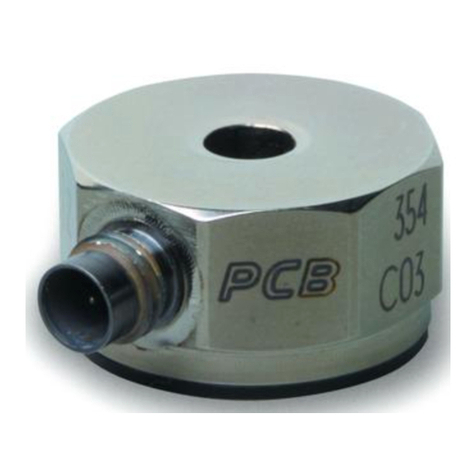
PCB Piezotronics
PCB Piezotronics M354C03 Installation and operating manual
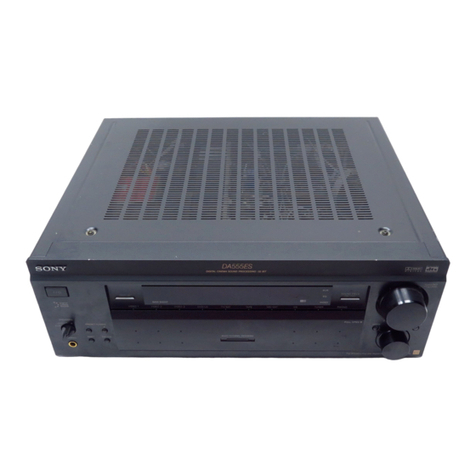
Sony
Sony STR-DA333ES - Fm Stereo/fm-am Receiver operating instructions
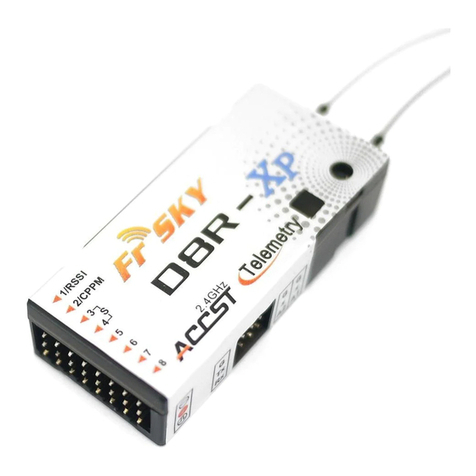
FrSky
FrSky D8RSP instruction manual
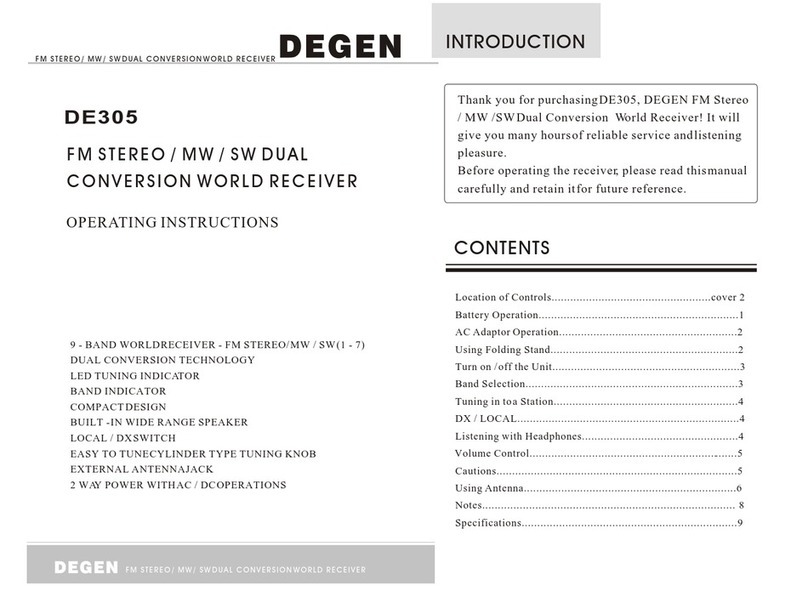
DEGEN
DEGEN DE305 operating instructions
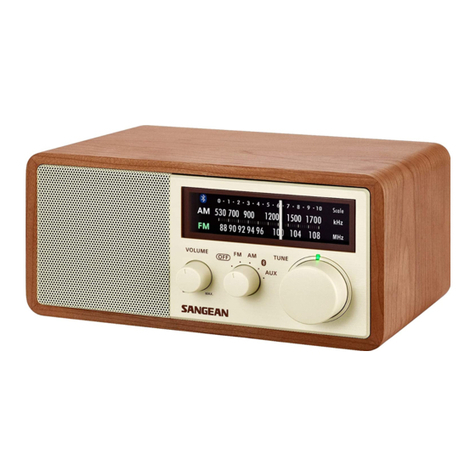
Sangean
Sangean WR-16 operating instructions

Oehlbach
Oehlbach BTR Innovation 5.2 operating instructions
